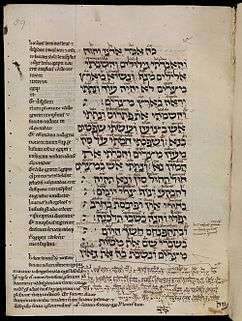Ezekiel 11
| Ezekiel 11 | |
|---|---|
 Book of Ezekiel 30:13–18 in an English manuscript from the early 13th century, MS. Bodl. Or. 62, fol. 59a. A Latin translation appears in the margins with further interlineations above the Hebrew. | |
| Book | Book of Ezekiel |
| Bible part | Old Testament |
| Order in the Bible part | 26 |
| Category | Nevi'im |
Ezekiel 11 is the eleventh chapter of the Book of Ezekiel in the Hebrew Bible or the Old Testament of the Christian Bible. This book contains the prophecies spoken by the prophet Ezekiel, and is one of the Books of the Prophets.[1]
Text
- The original text is written in Hebrew language.
- This chapter is divided into 25 verses.
Textual versions
Some most ancient manuscripts containing this chapter in Hebrew language:
- Masoretic Text (10th century)
- Dead Sea Scrolls: (2nd century BC[2][3]
- 4Q73 (4QEzeka): extant verses 1‑3, 5‑11
- 11Q4 (11QEzek): extant verse 19
Ancient translations in Koine Greek:
- Septuagint
- Theodotion version (~AD 180)
Verse 1
- Moreover the spirit lifted me up,
- and brought me unto the east gate of the Lord's house, which looketh eastward:
- and behold at the door of the gate five and twenty men;
- among whom I saw Jaazaniah the son of Azur,
- and Pelatiah the son of Benaiah, princes of the people.[4]
- "Jaazaniah the son of Azur" Not to be confused with "Jaazaniah the son of Saphan" in Ezekiel 8:11. A seal dated to 7th century BC with the name "Jaazaniah" was found, although the exact identification to which Jaazaniah is difficult.[5]
- "Pelatiah" (Hebrew: פלטיהו pə-laṭ-yā-hū; Greek: Φαλτιας, Φαλεττι(α); Pelatyahu or Pelatyah[6]): means "whom Jehovah delivered."[7] His death is noted in Ezekiel 11:13.
Verse 22
- Then did the cherubims lift up their wings, and the wheels beside them; and the glory of the God of Israel was over them above. [8]
Verse 23
- And the glory of the LORD went up from the midst of the city,
- and stood upon the mountain which is on the east side of the city.[11]
- "Glory" (Hebrew: כבוד kə-ḇōḏ): among other meanings of the Hebrew word, "abundance, riches" or "honour, splendour", which accompanies or surrounds the presence of God (YHWH) as in Exodus 24:16; 1 Kings 8:11; Isaiah 6:3; Ezekiel 1:28, compared to Luke 2:9.[12][13]
- "Mountain which is on the east side of the city": is interpreted by New Oxford Annotated Bible as "the Mount of Olives."[14]
See also
|
|
|
Notes and references
- ↑ Theodore Hiebert, et al. 1996. The New Interpreter's Bible: Volume VI. Nashville: Abingdon.
- ↑ Timothy A. J. Jull; Douglas J. Donahue; Magen Broshi; Emanuel Tov (1995). "Radiocarbon Dating of Scrolls and Linen Fragments from the Judean Desert". Radiocarbon. 38 (1): 14. Retrieved 26 November 2014.
- ↑ Ulrich 2010, p. 587.
- ↑ Ezekiel 11:1
- ↑ Bromiley & 1995 374.
- ↑ Brown, 1994 & "כְּפלטיה".
- ↑ Gesenius, 1979 & "פלטיה".
- ↑ Ezekiel 11:22
- ↑ Brown, 1994 & "כְּרוּב".
- ↑ Gesenius, 1979 & "כְּרוּב".
- ↑ Ezekiel 11:23
- ↑ Brown, 1994 & "כָּבוֹד".
- ↑ Gesenius, 1979 & "כָּבוֹד".
- ↑ The New Oxford Annotated Bible with the Apocrypha, Augmented Third Edition, New Revised Standard Version, Indexed. Michael D. Coogan, Marc Brettler, Carol A. Newsom, Editors. Publisher: Oxford University Press, USA; 2007. pp. 1193-1194 Hebrew Bible. ISBN 978-0195288810
Bibliography
- Bromiley, Geoffrey W. (1995). International Standard Bible Encyclopedia: vol. iv, Q-Z. Eerdmans.
- Brown, Francis; Briggs, Charles A.; Driver, S. R. (1994). The Brown-Driver-Briggs Hebrew and English Lexicon (reprint ed.). Hendrickson Publishers. ISBN 978-1565632066.
- Clements, Ronald E (1996). Ezekiel. Westminster John Knox Press. ISBN 9780664252724.
- Gesenius, H. W. F. (1979). Gesenius' Hebrew and Chaldee Lexicon to the Old Testament Scriptures: Numerically Coded to Strong's Exhaustive Concordance, with an English Index. Translated by Tregelles, Samuel Prideaux (7th ed.). Baker Book House.
- Joyce, Paul M. (2009). Ezekiel: A Commentary. Continuum. ISBN 9780567483614.
- Ulrich, Eugene, ed. (2010). The Biblical Qumran Scrolls: Transcriptions and Textual Variants. Brill.
External links
Jewish
Christian
This article is issued from
Wikipedia.
The text is licensed under Creative Commons - Attribution - Sharealike.
Additional terms may apply for the media files.